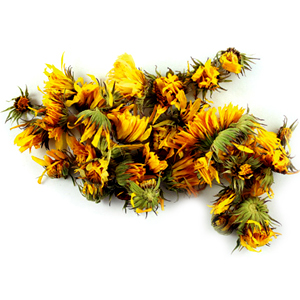No products
Pot Marigold bloom - 50g
(Flos callendulae cum calyce)
Pot Marigold (Calendula officinalis) bloom is applied externally and internally. Internally is used in diseases of the liver, gallbladder and gastric. It has antispasmodic properties, regulates menstruation, improves blood circulation and the heart´s action. Lowers blood pressure...
![]()
Content |   |
Binomial nameCalendula officinalis Commonly called (often known as)Ruddles, Common marigold or Scotch marigold StorageStore in a dry place at a temperature up to 25°C |
Description of herb
Pot Marigold (Calendula officinalis) is a medicinal plant that is used externally and internally.
In particular, the whole flower is collected, including the calyx (Flos calendulae cum calice), preferably in dry weather. The dried flower should be protected from light and because it easily absorbs air humidity, it is recommended to dry it occasionally.
Healing effects
Internal use
When used internally, it is excellent for liver and gallbladder diseases, aids digestion, has anticonvulsant properties, regulates menstruation, soothes inflammation of the digestive system, has a beneficial effect on gastric ulcer, improves blood circulation and improves heart function, lowers blood pressure, calms the central nervous system.
It heals eye and ear inflammation, it can also be used as a gargle for the oral cavity.
In the form of tea, marigold is excellent for inflammation of the bladder and urinary tract. It is one of the best drugs used in the supportive treatment and prevention of cancer of the female genitals and breast, stomach, liver, colon, skin.
She also has good "feminine qualities" because she helps with heavy and long-lasting menstruation. One week before it starts, you need to drink two cups of marigold tea a day.
External use
The external use of marigold is
- for heavily healing wounds and ulcers, mostly in the form of compresses or ointments
- it also helps very well with minor injuries and pain around the nails
- Mayflakes boiled in ointment (usually in lard or oil) are also very good for varicose veins, blood bruises, swelling, bedsores, scabs, mold on the feet, frostbite and cracks in the nipples after breastfeeding, while not harming the baby
- Marigold is also excellent for sitting baths with inflammation of the large intestine
- The tincture form is great for non-healing wounds, bleeding and bruising
- fresh squeezed juice is used for painting on skin cancer and age pigment spots
The healing effect of marigold on the healing of various wounds, eczema and skin defects is attributed to the action of phytoncides, plant antibiotics that act against bacteria and fungi. It is also used in cosmetics, where it uses its ability to soften the skin, its healing effects improve creams and other skin products.
Active substances
- essential oils
- carotenoids
- triterpene saponins
- flavonoids
- flavonoid glycosides
- salicylic acid
- vitamin C
- slime
- sesquiterpen calendin
- bitter calenden
Properties
Antibacterial, antifungal, anti-infective, anti-inflammatory, antioxidant, antiseptic, anticonvulsant, antiviral, laxative, astringent, detoxifying, sweating, estrogenic, hemostasis, immunostimulatory, healing.
Recommended at
Acne, sports leg, blepharitis, Candida, cold sores, conjunctivitis, cough, convulsions, eczema, fungal infections, gastritis, good digestion, hemorrhoids, HIV, menopausal symptoms, menstrual cramps, minor burns, alleviation of colitis, shingles, pain in throat, skin ulcers, snake bites, sprains, sunburn, varicose veins, viral infections, warts, wounds.
Preparation and dosing
TEA
Preparation: Topped spoon of dried marigold flowers per 1/4 liter. As a prevention 1-2 cups of tea a day for an adult. As a treatment 3-4 cups a day for an adult (a tablespoon every quarter hour).
Dosing: For cleansing the blood, for infectious jaundice, liver disease, roundworms, diarrhea, inflammation of the colon, to improve digestion, for delayed or painful menstruation.
TINCTURE
Preparation: A handful of flowers per 1 liter of 50% alcohol, let it infuse for 14 days in the sun or at a temperature of 20°C.
Dosing: To enhance the effects of tea, such as dressings for wounds, bruises, bleeding, muscle strain, purulent ulcers, swelling and tumors.
Side effects
Marigold has no side effects and can be used long term. It is well tolerated by children and the elderly.
REMEMBER: Tell all your health care providers about any complementary health practices you use. Give them a full picture of what you do to manage your health. This will help ensure coordinated and safe care.

